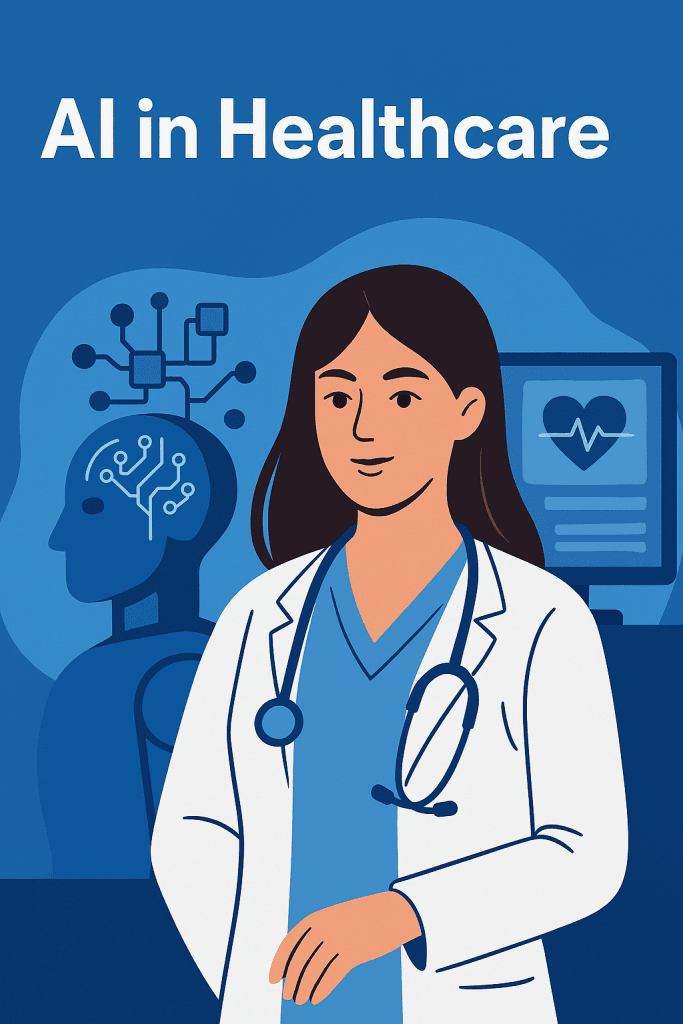Healthcare is on the brink of a revolution—and at the heart of it is artificial intelligence. Gone are the days when diagnoses depended solely on human judgment or data was manually processed by overworked staff. Today, machine learning (ML), a powerful subset of AI, is transforming everything from early disease detection to personalized treatment plans, and even how surgeries are performed.
With an increasing global demand for faster, more efficient, and patient-centered care, healthcare systems are under pressure to evolve. AI isn’t just an add-on technology—it’s rapidly becoming the core engine driving innovation, precision, and efficiency in modern medicine.
In this article, we dive deep into how machine learning is reshaping healthcare as we know it, offering actionable insights, real-world examples, and a hopeful glimpse into a smarter future for patients and providers alike.
Understanding the Basics: What Is Machine Learning?
Machine learning is a form of artificial intelligence where computers learn from data and make predictions or decisions without being explicitly programmed. In healthcare, this means algorithms can be trained on vast datasets to recognize patterns, identify anomalies, and assist medical professionals in making accurate, faster, and more data-driven decisions.
Key components of ML in healthcare include:
- Supervised Learning: Trains algorithms on labeled data, often used in image recognition (e.g., identifying tumors in scans)
- Unsupervised Learning: Identifies patterns in unlabelled data, useful for patient segmentation and population health
- Reinforcement Learning: Learns by trial and error, particularly promising in robotic surgery and treatment optimization
With the sheer volume of health-related data being generated daily—from electronic health records (EHRs) to wearable tech—machine learning is the perfect partner to transform raw data into meaningful medical insights.
AI and Machine Learning vs Traditional Healthcare Models
Traditional healthcare systems rely on human diagnosis, intuition, and reactive treatment approaches. While effective to a degree, this model often suffers from delays, misdiagnoses, administrative overload, and lack of personalization.
Machine learning, in contrast, brings:
- Speed: Algorithms can process data in seconds
- Accuracy: Reduced human error through pattern recognition
- Proactivity: Predictive models flag issues before symptoms appear
- Personalization: Tailored care plans based on individual genetic, behavioral, and lifestyle data
ML doesn’t replace human doctors—it augments their capabilities, allowing them to spend more time with patients and make better-informed decisions.
Early Disease Detection: Catching Illness Before It Strikes
One of the most transformative applications of AI in healthcare is its ability to detect diseases early—often before physical symptoms arise.
Examples include:
- Cancer detection: ML algorithms analyze medical images (CT scans, mammograms, MRIs) to identify malignant tumors with higher accuracy than the human eye.
- Diabetes prediction: AI models can evaluate blood sugar patterns, genetic markers, and lifestyle data to predict the likelihood of type 2 diabetes years in advance.
- Cardiovascular risk assessment: By analyzing EHRs and biomarkers, ML can flag patients at high risk of heart attacks or strokes, prompting early intervention.
In early detection, time equals lives saved—and machine learning is giving us time we didn’t have before.
Diagnostic Precision: Enhancing Accuracy with AI
Medical misdiagnosis is a leading cause of preventable harm in healthcare. Machine learning is helping solve this problem by acting as a second set of eyes—or more accurately, a supercomputer trained on millions of patient cases.
AI-assisted diagnostics are now being used to:
- Interpret pathology slides with extreme precision
- Detect rare diseases through pattern recognition in genetic data
- Differentiate between similar conditions with overlapping symptoms
For instance, Google Health’s AI model has shown better breast cancer detection rates than radiologists in some trials. And DeepMind’s algorithm can detect over 50 eye conditions from retinal scans with specialist-level accuracy.
These advancements don’t aim to replace clinicians but to equip them with better tools for decision-making.
Predictive Analytics: Anticipating Future Health Events
What if doctors could anticipate your next ER visit or detect a disease before it manifests? That’s the promise of predictive analytics, a powerful application of ML in healthcare.
Hospitals are using predictive models to:
- Prevent hospital readmissions by identifying high-risk patients
- Forecast outbreaks based on population and environmental data
- Optimize staffing and resources in emergency departments
At an individual level, predictive analytics can suggest lifestyle or medication changes to prevent illness altogether. It’s a shift from reactive care to preemptive and preventative care.
Personalized Medicine: One Size No Longer Fits All
Traditionally, treatments have been based on population averages. But every human body is unique, and what works for one may not work for another. Machine learning is unlocking personalized medicine—where treatment is tailored to your DNA, habits, and health history.
Applications include:
- Identifying the best chemotherapy drug for a specific genetic tumor profile
- Adjusting medication dosages using real-time health data from wearables
- Creating nutrition or exercise plans based on metabolic data
By understanding how different patients respond to treatments, ML models can help providers minimize trial-and-error and maximize outcomes.
Virtual Health Assistants: AI-Powered Care Beyond the Clinic
AI doesn’t stop at diagnosis or data analysis. Virtual health assistants are revolutionizing how and when care is delivered, especially for patients managing chronic conditions.
These tools can:
- Monitor symptoms and provide medication reminders
- Alert doctors in case of abnormal readings
- Guide patients through mental health exercises or rehabilitation routines
For example, apps like Woebot offer AI-powered CBT therapy through text conversations, providing emotional support that’s available 24/7.
This kind of AI-driven support empowers patients to take charge of their own care, improving engagement and adherence.
Robotic Surgery and Precision Procedures
Machine learning is also improving surgical outcomes by enhancing the precision and control of robotic-assisted surgeries.
These systems:
- Reduce tremors and increase dexterity for complex operations
- Use AI to plan surgical paths with less risk
- Provide real-time data feedback for safer procedures
Robotic surgery, powered by machine learning algorithms, often results in shorter hospital stays, less scarring, and faster recoveries.
Managing Big Data in Healthcare with Machine Learning
Healthcare generates enormous volumes of data—from imaging and labs to wearables and administrative records. ML excels at sifting through this ocean of information to find what matters.
Benefits of ML-driven data management include:
- Streamlined workflows for clinicians
- Automated medical coding and billing
- Improved resource allocation and inventory management
- Enhanced clinical research through pattern discovery
By organizing and analyzing data faster than any human ever could, ML frees up valuable time and reduces system inefficiencies.
Public Health and Population-Level Insights
Beyond individual care, machine learning plays a vital role in public health and healthcare policy.
Examples include:
- Tracking and predicting disease outbreaks (e.g., COVID-19 spread models)
- Identifying health disparities across regions or populations
- Analyzing vaccine effectiveness in real-time
- Informing public health messaging and policy decisions
Machine learning turns scattered public health data into actionable strategies that can benefit millions.
AI in Mental Health: The Invisible Crisis
Mental health often goes undetected and untreated—but machine learning is helping change that.
AI can:
- Analyze speech patterns or facial cues to detect early signs of depression
- Track behavior changes through wearable data
- Provide AI chatbots that offer immediate emotional support
With stigma still surrounding mental health, AI offers private, immediate, and stigma-free support, opening access to care for those who might otherwise stay silent.
Challenges and Ethical Considerations
Despite its promise, AI in healthcare also raises crucial questions.
Key challenges include:
- Data privacy and security: Health data must be protected from breaches or misuse
- Bias in algorithms: Models trained on biased data can worsen healthcare disparities
- Accountability: Who is responsible when AI makes an error?
- Transparency: Patients and providers must understand how decisions are made
Ethical AI in healthcare must be transparent, inclusive, and human-centered. Trust and regulation will play key roles in its sustainable adoption.
Real-World Case Studies
Several institutions have already implemented AI with remarkable success
- Mayo Clinic uses AI to predict patient deterioration in real-time, allowing faster ICU interventions
- Stanford Medicine uses deep learning to identify skin cancer as accurately as dermatologists
- Mount Sinai Hospital uses predictive analytics to manage sepsis risks in emergency rooms
These aren’t experiments—they’re functioning models of better care.
The Future: What’s Next for AI in Healthcare?
Machine learning is evolving rapidly. Future trends include:
- Federated learning for cross-institution model training without data sharing
- Explainable AI to make models more transparent and trustworthy
- Real-time diagnostics embedded into wearable tech
- Voice-activated medical assistants that take notes and manage EHRs
As these innovations grow, so will our ability to provide faster, fairer, and more intelligent care for every human.
Conclusion: A Smarter Future for Healthcare
Machine learning in healthcare isn’t just a technological upgrade. It’s a paradigm shift—one that puts patients at the center, clinicians in control of better tools, and systems in a position to heal more efficiently.
From early detection and diagnostics to personalized care and predictive insights, ML is turning healthcare into a proactive, precise, and patient-driven ecosystem. It won’t replace the human touch—but it will amplify it.
The question is no longer whether we should embrace AI in healthcare—but how quickly we can harness its full potential to improve lives.
FAQs
Machine learning analyzes vast amounts of data to predict outcomes, personalize care, and support clinicians—something traditional methods can’t match at scale.
No. AI augments doctors’ abilities. It assists with decision-making, diagnostics, and data processing, but the human element remains essential.
Risks include biased data, lack of transparency, privacy concerns, and overreliance on machines without clinical judgment.
Hospitals use AI for patient monitoring, diagnostic imaging, resource management, robotic surgery, and chat-based triage tools.
Yes. AI can extend care to rural or underserved areas through telemedicine, mobile diagnostics, and accessible digital tools—if deployed ethically.
Most reputable systems use anonymized, encrypted data. However, data protection policies and user consent are crucial for ethical use.








Post a comment